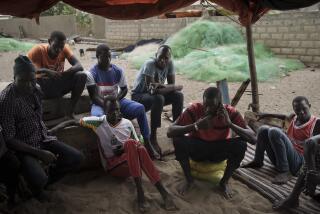Postscript : Where Seeds of Slavery Took Root : Thousands still visit Senegal island where Africans were held en route to New World.
- Share via
GOREE ISLAND, Senegal — For this story, we have only our imaginations. No one today can tell us how it was.
We come here and sniff the sea breeze and walk the sandy beach and are drawn inside the heavy stone walls of Goree Island’s slave house.
There is a courtyard and two outdoor staircases covered with plaster. The paint is fresh, whitish, the color of sherbet. At first glance, there is absolutely nothing wrong here. Except there is that door that opens west to the sea.
So imagine: Stumbling through that low passage of damp stones. A coarse chain bites into your leg, maybe into your neck.
You are shoved out onto the wooden dock, naked and wet with sweat. After the gloom of a dungeon cell, the tropical sun is blinding.
Maybe you can gather the silhouette of the slave ship out there at the end of the planks?
That much we can imagine.
We can guess that the sea breeze smelled just the same then as now. Surely it was refreshing after the stench inside. Maybe gulls glided overhead.
But what of the mind? Can we really have any inkling of the thoughts that come to a human prodded down the dock by men who speak a language understandable only in its cruelty?
Along with foreboding do these captives feel melancholy? Fear? Anger?
Do they pray? Curse?
Do they look back for a last glimpse of Africa? Are their eyes filled with tears? Is there anything in their pounding hearts except ache?
They will take nothing with them, not even their names. So there will be no heirlooms, no bits of Africa, that their families can pass on to the great-great-great-great-grandchildren who today are members of Congress, U.S. Army officers, teachers, firefighters, doctors, National Basketball Assn. superstars and a thousand other things in the land to which these slaves are bound.
“I call this the door to the voyage without return,” says conservator Joseph Ndiaye, who conducts morning and afternoon tours of the restored Goree Island Maison des Esclaves. “But when I see my African American cousins come here, I realize that is a mistake. Because now you come back.”
Each year, a few thousand Americans, black and otherwise, journey here to their nation’s African past--20 minutes on the rusty ferryboat Blaise Diagne from Dakar, the Senegalese capital.
Just outside Dakar’s industrial harbor is this tropical islet, which stood for three centuries as one of the major stops on the slave route to the New World.
Through here passed untold legions of men, women and children from what today are Nigeria, Cameroon, Ghana, Senegal, Benin, Zaire.
The official history of the island has it that 15 million to 20 million slaves came through Goree.
Niara Sudarkasa, an American anthropologist and president of Lincoln University in Pennsylvania, says the number was probably closer to 1.2 million in the shameful centuries of African slavery, from the mid-1500s to the mid-1800s.
Beyond Goree, it was 500 miles over the horizon to the next slave station at the Cape Verde Islands, 3,000 miles more to the plantations of America.
And many Goree Island slaves were dispersed to Haiti, the West Indies and Latin America.
Designated a historical site by the Senegalese government, the slave house--which stands today among the private residences, restaurants, shops and aging fortresses of Goree--is said to date from 1776.
It was built to imprison 100 to 150 slaves in dank stone chambers on the ground floor, while traders resided in broad-veranda comfort above and waited for ships to come in.
In the past, the island flourished with such houses: high-plastered walls encasing a Mediterranean courtyard with rooms and quarters all around. A single wooden door led in. And one led out.
Like that of the Vietnam Veterans Memorial in Washington, the power of this place lies in how a simple structure works on our consciousness and our conscience.
There are no signs, only one display case, no T-shirt vendors or gift shop. Just the quiet scrape of shoes over dusty floors as a handful of visitors each day explore the empty rooms and gaze through the west-pointing door.
And there is the voice of curator Ndiaye, speaking in native Wolof, as he narrates his own view of life as a slave in passage: “Here, families were separated forever. . . . Women were taken in this room for intercourse, and they submitted because if they got pregnant they were released. . . .
“Under the staircases are the cells for those who would be reluctant to accept their plight. A weighing room, here, because the price of a man was commensurate with his weight and strength. . . .
“The weak died and were thrown to the sea, which kept the sharks at the shore.”
And then it is quiet. Visitors stand still. The shrieks of history cannot be heard, but they can be acknowledged. Inside these walls were great plagues, like the one that swept Goree in 1779.
Who among our friends and families carry bloodlines of those who lay sick on these bare, dirty floors that year?
“I looked forward to this,” says Calvin Mitchell, a U.S. government worker visiting from Washington, D.C. “But as an African American, my feelings are deeply contradictory. . . .”
Ironically, the name Goree comes from the Flemish word meaning haven. Shielded by the Cape Verde peninsula, the waters here offered moorage for large ships. The northerly trade winds offered the promise of swift passage. Over the centuries, control of the island was disputed variously by the Dutch, Portuguese, French and British--free traders all in the commodity of humans.
The slave house stands on a narrow stone path, just up from the crescent-shaped beach where boys dive in the clear water for coins when the ferry docks.
Today, residents of the island lug precious water to their homes by bucket. In the arid Senegalese climate, cactus survives alongside flowering trees. Sheep skitter up the path past women in their lavish Senegalese boubou gowns.
Barely 50 yards from the front door of the slave house, sun-bleached outdoor cafes with thatched roofs stand in a row, serving cold beer and seafood with sweet limes.
On either end of the boot-shaped island are remnants of old forts; slaving was worth fighting for.
The ferry horn sounds. Visitors move to the harbor.
Ndiaye retreats to his sagging, dusty desk in the slave house, and from his own acute imagination he pens homilies, one after another.
“The gift of liberty gave to men the faculty to destroy it,” he writes. “Oh, Goree Island, how many caravels threw their anchor into your heart?”
More to Read
Sign up for The Wild
We’ll help you find the best places to hike, bike and run, as well as the perfect silent spots for meditation and yoga.
You may occasionally receive promotional content from the Los Angeles Times.






